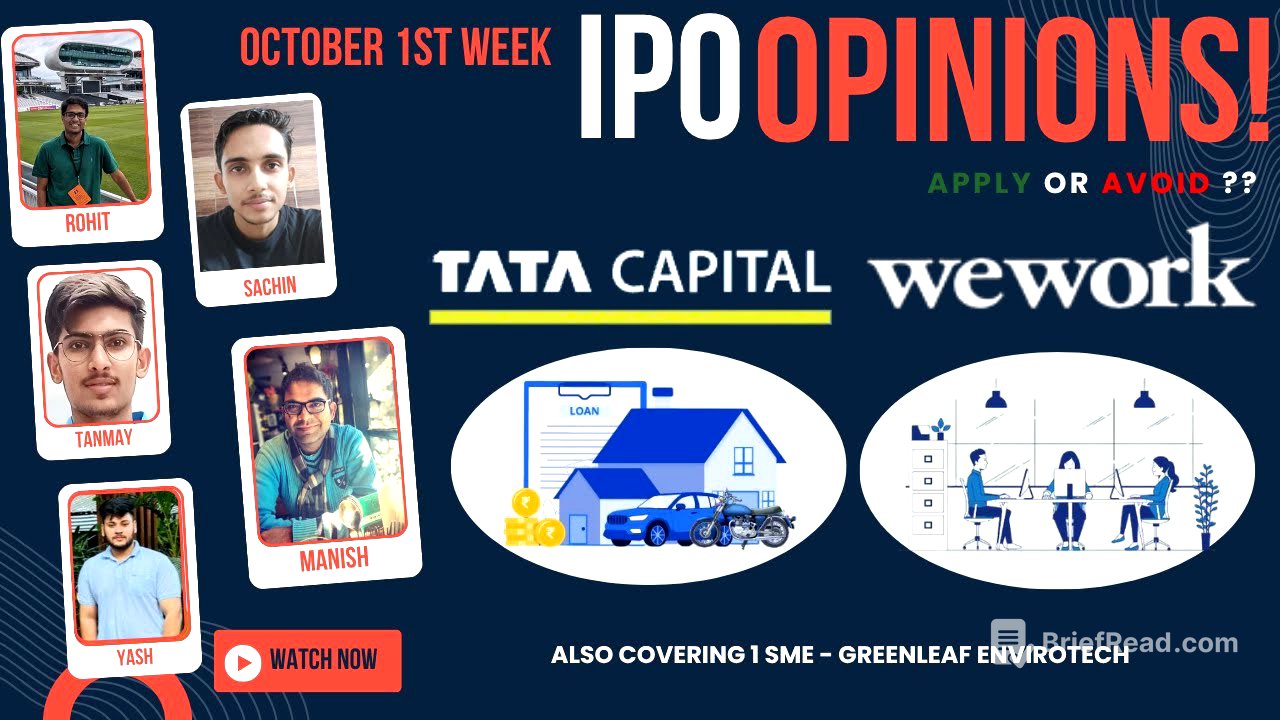TLDR;
This YouTube video by Sunday Investing gives a breakdown of the IPOs coming out in the first week of October. They talk about WeWork India, Greenleaf Envirotech, and Tata Capital. They share their opinions on whether or not to invest in these IPOs, keeping in mind that this is just their personal opinion and not qualified financial advice.
- WeWork India: Good brand, premium inventory, but high dilution.
- Greenleaf Envirotech: High regional concentration, fixed price issues.
- Tata Capital: Large IPO, diversified NBFC, decent valuations.
Opening Remarks [0:00]
The video is about the IPOs coming out in the first week of October. This week has fewer IPOs, but the amount of money being raised is quite high. They'll be discussing Tata Capital (₹15,000 cr IPO), LG (₹11,000 cr IPO), WeWork (₹3,000 cr IPO), and a few SMEs. In this episode, they will cover WeWork, Greenleaf Envirotech, and Tata Capital. They remind viewers that their opinions are not qualified financial advice and to do their own research before making any investment decisions. They also encourage viewers to join their YouTube channel and follow them on Instagram for more IPO-related content.
WeWork India (Mainboard) [2:35]
WeWork India, incorporated in 2016, is a flexible workspace operator with 68 operational centers across eight Indian cities, mainly in Bangalore and Mumbai. It is considered a better brand in the B2C space compared to other players. The IPO is ₹3,000 crores, entirely an Offer For Sale (OFS), with a market cap of ₹8,600-8,700 crores. There's a significant 35% dilution, meaning the company promoters are exiting. In terms of financials, the revenue is ₹2,128 crores.
WeWork India is the largest flexible workspace solutions provider in India, known for its premium inventory. Their realization per seat is ₹19,000-20,000, higher than other operators (₹9,000-12,500), due to better quality and premium locations like BKC and Embassy. The company is owned by Embassy Group, a reputed real estate giant. They have 1.15 lakh operational seats, 68 centers, and a leasable area of 7.7 million sq ft. WeWork is 40-45% bigger than the second player and 3.5 times more profitable. The ₹3,000 crore raise is a complete OFS because the company has a lot of cash and the promoters cleared off debt six months ago. The company generates ₹300-400 crores of profits and doesn't need money for capex. They plan to increase operational seats by 20% CAGR, requiring a capex of ₹200-220 crores in FY26 and ₹250-260 crores in FY27, which they can easily cover with their cash flow.
WeWork has the best margins in the industry, with cash margins at 21.6%. In FY23, they had a revenue of ₹1,423 crores and a PAT of ₹191 crores (14.5% margin). In FY24, revenue was ₹1,737 crores and PAT was ₹340 crores (20.4% margin). In FY25, revenue was ₹2,224 crores and PAT was ₹421.3 crores (21.6% margin). The financials are IGAP, not IndAS, because IndAS is aggressive in accounting for co-working companies, considering lease payments below EBITDA, making margins look artificially high. The company's market cap is ₹8,685 crores, with a valuation of 20.5 times FY25 PAT and 15.5 times FY26 PAT. They have a 20% operational capacity CAGR and 74% blended level utilization in FY25. Management expects a 22% topline growth in FY26, translating to a revenue of ₹2,450-2,500 crores and a PAT of ₹550-570 crores.
WeWork is ranked first in India, followed by Table Space, TEC, Smartworks, Office, and IndiQube. WeWork's valuation is lower compared to peers like Smartworks, Office, and IndiQube. WeWork is the only Indian operator with global access, beneficial for high-level management needing workspaces in different geographies. They have industry-beating numbers in terms of ROCE (80-90%) and margins. In 2023, WeWork Global went bankrupt, but in 2025, a new group took over and the company is running smoothly. The promoter, Embassy Group, owns 74% equity before the IPO and 47% post-IPO. WeWork Global invested $200 million in 2019 for 22% equity. Client base is strong, with 25% revenue from Fortune 500 companies, 25% from enterprise companies, and 20% from top-tier startups. Services contribute 12% revenue, the highest in the industry. Overall, it's a good apply, and the anchor book was fantastic.
One concern is the competitive market with many co-working companies and infra companies starting their own co-working spaces. Also, occupancy has been going down, currently at 76%. The dilution of ₹3,000 crores is also a concern. However, the increase in new inventory and a higher percentage towards co-working contribute to better margins. The company has low exposure towards IT, a boom in GCCs, and premium inventory, driving growth. The industry is expected to grow at 20% for the next four years. The speaker thinks this should be an easy subscription, with less retail participation meaning less flipping. The anchor book has high-quality names like Urban Company and CP Plus.
Greenleaf Envirotech (SME) [29:32]
Greenleaf Envirotech, incorporated in 2010, provides EPC and turnkey solutions for wastewater treatment projects, focusing on sewage treatment plants (STPs) and effluent treatment plants (ETPs). The IPO is ₹22 crores, with 18% fresh issue and some percentage OFS. The market cap is ₹81 crores, with a 27-28% dilution. In terms of financials, the topline is ₹39 crores and bottom line is ₹51 crores. The lead manager is Smart Horizon.
Greenleaf Envirotech started in 2010, providing EPC services for wastewater and sewage treatment plants. 92-93% of revenues come from EPC, and the rest from O&M contracts for 3-4 years. They have an order book of ₹155 crores comprising 17 projects. Their tender win rate is around 20-22%. They have moved from subcontracting to direct contracting. In FY23, they had ₹26 crores revenue with 8% EBITDA, largely from subcontracting. In FY24, revenue was ₹33 crores with 11% EBITDA. In FY25, revenue rose to ₹39 crores and EBITDA to 17% with 12% PAT margins, as subcontracting fell to 30-35%. They are projecting 50-60% growth for the current year.
A risk is that 75-80% of revenue comes from Gujarat, indicating high regional concentration. The promoter group has unlisted entities doing similar work, and non-competition agreements are not foolproof. Subcontracting is not totally gone, affecting margins. All projects are fixed price, so they cannot pass on raw material price increases to customers. The IPO is a fixed price issue with no anchors. Proceeds will be used for new machinery, lab testing equipment, loan repayment, and working capital. The pricing for FY25 is near 17 times, and for FY26, it may be near 13 times. There are many peers in the SME and mainboard space, such as Satwa Engineering and Apex Ecotech. Felix Industries has higher margins and better technology. The lead manager, Smart Horizon, is decent. The sector is currently derated, and companies with higher growth and margins should get better multiples. Greenleaf is not talking about new technologies like zero liquid discharge. They are lower in the value chain of water treatment solutions. The speaker is not interested in this IPO.
Tata Capital (Mainboard) [36:33]
Tata Capital, incorporated in 1991, is a subsidiary of Tata Sons Private Limited and operates as an NBFC in India, offering consumer loans, commercial finance, IB private equity, and clean tech financing solutions. The IPO size is ₹15,500 crores, with ₹6,850 crores fresh issue and ₹8,500 crores OFS. The market cap is ₹1.44 lakh crores. In FY25, the revenue was ₹28,370 crores and PAT was ₹3,600 crores. The lead managers are Axis, BNP Paribas, Citi, and HDFC.
Tata Capital is India's third-largest NBFC with an AUM of ₹2.3 lakh crores. It is the flagship financial services arm of the Tata group, post-merger of TMFL (Tata Motors Finance). They offer housing finance, corporate and MSME loans, CV vehicle financing, green financing, supply chain financing, equipment financing, loan against securities, education loans, personal loans, consumer loans, microfinance, and lease rental financing. Tata Capital doesn't have a hero product like other NBFCs; they are diversified between housing finance, MSME loans, and CV finance. They also have fee-based services like distribution of third-party credit cards and insurance, health management schemes, and AIFs. 98% of their revenue is from financing, and 2% is fee-based, which is still a large ₹550-600 crores. They have 1500+ branches in 27 states and union territories and are an AA-rated NBFC.
They are raising ₹15,512 crores, with ₹6,846 crores fresh issue for augmentation of tier one capital and ₹8,666 crores OFS. In FY23, total income was ₹13,637 crores, NIM was ₹6,150 crores, and PAT was ₹3,029 crores. In FY24, revenue was ₹18,200 crores, NIM was ₹871 crores, and PAT was ₹3,150 crores. In FY25, revenue was ₹28,370 crores, NIM was ₹13,35 crores, and PAT was ₹3,665 crores. In Q1, revenue was ₹7,665 crores, NIM was ₹3,442 crores, and PAT was ₹990 crores. Cost of borrowing is 7.8%, yield is 12.3%, ROE is 12.5%, and ROA is 1.8%. The Q1 numbers are impacted by the TMFL merger, as vehicle financing has higher provisions and NPA ratios.
Before the merger, ROE was 15%, ROA was 2.1%, and PCR was 65%. G&P is 2.1% as of Q1 FY26, while it was 1.5% before the merger. NNPS stands at 1%, compared to 0.5% before the merger, due to the 14% increase in AUM from Tata Motor Finance. The management expects the numbers to return to normal in a couple of years. Price to book at Q1 is coming four times. If you just add up the new capital and 25 to 27% ker on your normal net worth which has been from 25 22 to 28 you just add up around minus 2% I'm just taking 25 26% which should take you 326 price appro 2.8 times exactly 2.79 to P 2 so four times F25 Q1 and pre- money pre before the IPO 2.8 times post IPO FR 26 end very clear peers Bajad is at 6 * 6.2 2 * 25 5 * 26 chol is at 5 * e 26 f 26 sundra is at three times at three times frankly on the fin it should come significant but for this point it is at three times soam and baj are very different entities and extremely high quality entities this is also high quality for sure but a TMFL merger has slightly taken off that you know for at least like two or three quarters. The speaker feels it should get valued at three times F26 price to book in the shortest term, given its growth, Tata brand, and liquidity position.
The speaker feels it should get valued at three times F26 price to book in the shortest term, given its growth, Tata brand, and liquidity position. The CV should increase in your TMFL merger should by a decent margin should increase your name because it's a high margin product or your free based income should start from like 2% to 4% in like 2 years then your housing finance is doing well so overall three times for 26 post looks extremely reasonable so if you just extrapolate those numbers up 7% 7 and 7.5% to 7% for your extremely shortest long-term horizon would be at 3 and a half times 26 post money 26 is still predictable and I feel 27 number should be extremely better even if I go with those numbers with extreme hypothetical calculations around exopath exopath and half long 3.2 terms. So if I just put in extra those numbers long exact three and a half times 26 price. So but this is like I would say 3 to four kind of a view. So I feel uh so there is one more nuance right that was at 343 rupees per share percentage IP. So my view is very simple. Uh top class business house in the country. The best top best class. Second very high quality company. Uh TMFL merger. It was super relatively high quality. Now it is still high quality but super reason TMFL has bought the fundamentals at the lower end numbers. You have got the glimpse already. So uh finest business house uh very good business high quality high growth business very strong management good capital base good good good segments to operate in good geographical distribution uh valuations decent and honestly you know whatever these are these are not bad valuations so I feel at least personal levels say art% listing in clearly left on the table and at a one-year view I would say and at 1.58 lakh cr market is extremely good extremely good so so it is decently priced or better ten of that the things which are done are done. Uh so applying for small listing gains uh and I won't go it for longer because I'm not a fan of this sector. It would go at a good level for sure but I at personal level might not consider for a longest term you know medium base high growth companies so extremely large base but the people who like those uh industry beating returns let's say industry uh sorry market beating returns index beating returns like 12 and a half% averagely if you like 15 to 20% while band which is very good to safeguard and have a defense defensive portfolio like defensive. This is one of those companies which should give you some defense at your portfolio. So it is a very good company even for longest term as it is going to protect your portfolio and give very industryleading uh returns. So good for longterm uh short-term I doubt medium-term I doubt Q2 is going to be very critical number Q2 market so medium-term slight doubt short-term large doubt long-term bullish listing if not as per sentiment it is fairly possible reasoning the size of the IPO and I'll be very honest I won't lie That was my very personal opinion. But if I would So this was a just a tactic to increase the names in the anchor book and not the demand. very high doubt this is not possible so anchor was poor as per me very poor we work was 10 times better than this but you know finance companies market markets are not very bullish and that is fair also but I feel there's one more good point here uh the rural demand has been inching up the GST cuts are fueling growth for your mid-tier electronics market at the consumption from the Q to second half. Q to sec second half I mean is your August midepptember and even October is seeing fairly good as due to the f November should do fairly because that it would generate a pent-up demand which would par the increased inflation slight decreased tone in the November and that would be with a tone of decrease in the GST. Even November should be well. So uh this 3 months pent up uh demand for everything in the country should can act as a positive for the the finance companies and I feel this is extremely possible and markets might value this company at good multiples for 3 months. So my overall view is because the risk is favorable% I'm more than I would be easily booking my position if I see any return above 8.5% 8.5 any return I'm cing the stock at least for 10 five 10 days 5 10 days listing plus 2 3 days view low so I would apply not full force not a bad company very good company valance could have been better high quality business or platform band.
The speaker is applying for small listing gains but is not a fan of the sector long-term. It's a defensive stock that can protect your portfolio and give industry-leading returns. Short-term and medium-term are doubtful, but long-term is bullish. Listing gains are possible, but the size of the IPO is a factor. The anchor book was poor. Rural demand is inching up, and GST cuts are fueling growth for the mid-tier electronics market, which could be a positive for finance companies. The speaker would book profits if they see any return above 8.5%.
Closing Remarks [56:24]
Sachin will apply only in WeWork and skip Tata Capital and Greenleaf. The speaker is also unsure about WeWork and will be selective. They are saving money for LG. For Tata Capital, they won't go full force but will apply some. They expect mid to low mid single-digit listing gains. They are thankful for the coming of WeWork and expect some listing gains. They are comfortable holding WeWork because they have made money in this sector before. They will be applying in both the main boards, and more money will go towards LG. They rate the anchor book of WeWork as top third best. They encourage viewers to join their Instagram and YouTube channel.









